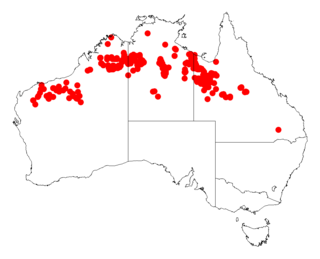
Acacia inaequilatera, commonly known as kanji bush, baderi, camel bush, fire wattle, kanyji bush or ranji bush is a tree in the family Mimosaceae. Endemic to Australia, it is widely distributed in the semi-arid Triodia country eastwards from Karratha, Western Australia into the Northern Territory.

Acacia eriopoda, commonly known as the Broome pindan wattle and the narrow-leaf pindan wattle, is a species of wattle in the legume family that is native to northern Western Australia. It is also known as Yirrakulu to the Nyangumarta people.

Acacia atkinsiana, commonly known as Atkin's wattle, is a species of flowering plant in the family Fabaceae, and is endemic to the north of Western Australia. The indigenous peoples of the area where the shrub is found, the Kurrama peoples, know the shrub as bilari or pilarri. It is an open, spreading, usually V-shaped shrub with very narrowly elliptic phyllodes and heads of oblong or spherical racemes of 70 to 90 densely-arranged flowers and linear pods up to 100 mm (3.9 in) long.

Acacia bromilowiana, commonly known as Bromilow's wattle, is a tree belonging to the genus Acacia and the subgenus Juliflorae that is endemic to a small part of north western Australia.

Acacia effusa is a shrub belonging to the genus Acacia and the subgenus Juliflorae that is endemic to north western Australia.

Acacia hamersleyensis, also known as Karijini wattle or Hamersley Range wattle, is a tree or shrub belonging to the genus Acacia and the subgenus Juliflorae. It is endemic to a small area in central Western Australia.

Acacia incurvaneura, also known as narrow-leaf wattle, is a shrub belonging to the genus Acacia and the subgenus Juliflorae that is endemic to central and western Australia.

Acacia macraneura, commonly known as big mac wattle, is a shrub belonging to the genus Acacia and the subgenus Juliflorae that is native to arid parts of western Australia.

Acacia pteraneura is a shrub belonging to the genus Acacia and the subgenus Juliflorae that is endemic to arid areas of central Australia.

Acacia rhodophloia, commonly known as minni ritchi or western red mulga, is a tree or shrub belonging to the genus Acacia and the subgenus Juliflorae that is endemic to a large area of arid central western Australia. The Indigenous group the Kurrama peoples know the plant as mantaru.

Acacia subcontorta is a shrub belonging to the genus Acacia and the subgenus Juliflorae that is endemic to central and central western Australia.

Acacia tenuissima, commonly known as narrow-leaved wattle, broom wattle, minyana, slender mulga or slender wattle, is a shrub belonging to the genus Acacia and the subgenus Juliflorae endemic to temperate and tropical areas of Australia. Indigenous Australians the Kurrama peoples know the plant as Janangungu and the Banyjima know it as Murruthurru.

Acacia marramamba, commonly known as marramamba, is a shrub or tree belonging to the genus Acacia and the subgenus Phyllodineae that is endemic to arid parts of western Australia.
Acacia minutissima is a shrub belonging to the genus Acacia and the subgenus Phyllodineae that is endemic to parts of western Australia.

Acacia pachyacra is a tree or shrub belonging to the genus Acacia and the subgenus Phyllodineae. that is endemic to arid parts of central and western Australia.

Acacia synchronicia, commonly known as bardi bush, is a shrub or tree of the genus Acacia and the subgenus Phyllodineae endemic to Australia.

Acacia arrecta, commonly known as yarnda nyirra wattle or Fortescue wattle, is a species of flowering plant in the family Fabaceae and is endemic to the Pilbara region of Western Australia. It is a compact, spreading shrub with curved, phyllodes that are round in cross-section, spherical heads of bright yellow flowers, and rigid, linear pods up to 55 mm (2.2 in) long.
Acacia graciliformis, also known as Koolanooka Delicate wattle, is a shrub of the genus Acacia and the subgenus Plurinerves that is endemic to a small area in western Australia.

Acacia retivenea, commonly known as the net-veined wattle, is a shrub of the genus Acacia and the subgenus Plurinerves that is endemic across northern Australia.

Acacia sericophylla is a shrub or tree commonly known as the desert dogwood, desert oak or cork-bark wattle. To the Indigenous Australian people of the Pilbara, the Nyangumarta peoples, it is known as Pirrkala. The species is of the genus Acacia and the subgenus Plurinerves.

















